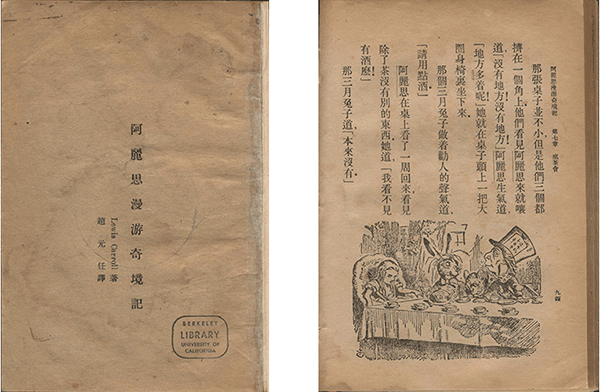4 Chinese

The concept of “children’s literature” was virtually foreign when Chao’s translation of Alice’s Adventures in Wonderland first appeared in China. Traditionally, children of the literate classes learned to read by memorizing and copying out primers, like the Three Character Classic 三字經, gradually moving on to the Confucian canon, dynastic histories, and standard compendia of classical literature. What fiction they read was written for adults.
This changed with the May Fourth Movement of 1919, which called for a number of reforms, including the use of vernacular, rather than classical, Chinese in all forms of writing. Some of the movement’s leaders further called for the development of a literature written for children, whether to free them of the intellectual constraints of traditional education, or to give them a psychological space of their own. First published in 1922, Chao’s translation of Alice can be viewed as an answer to both calls.
Alisi is not simply an historical artifact, however. As a linguist (albeit one who took degrees in mathematics and philosophy from Cornell and Harvard), Chao understood well the challenge of Carroll’s language — the puns, jingles, nonsense words of inexhaustible significance. How were these to be rendered in a written vernacular associated with any number of dialects, all abounding in homophones, linguistically and culturally unrelated to Victorian English? It is Chao’s solution to this challenge that continues to impress scholars and tickle readers almost a century after the book’s publication.
Chao joined the Berkeley faculty in 1947. By that time, Chinese had been a regular feature of the curriculum for fifty years, due to regent Edward Tompkins’ gift of the Agassiz professorship of East Asian Languages and Literature, the first chair endowed at the University. Tompkins’ primary motive in creating the chair was to benefit the state’s residents and its economy. He had seen trade developing between California and Asia, particularly China and Japan; but he knew that if it was to flourish, California businessmen must understand something of the language and culture of their Asian counterparts. Tompkins had a secondary motive as well. He had seen Asian students and scholars disembark at San Francisco only to board trains to the east, to established seats of learning. Tompkins wanted California, one day, to possess the same intellectual allure and pull. By Chao’s day, it clearly did.
Contribution by Deborah Rudolph
Curator, C. V. Starr East Asian Library
Title in English: Alice’s Adventures in Wonderland
Authors: Lewis Carroll; Yuen Ren Chao 趙元任 (trans.)
Imprint: Shanghai: Shanghai yin shu guan, 1939.
Edition: 4th
Language: Chinese
Language Family: Sino-Tibetan
Source: English-Chinese edition published in 1988 through the Library’s subscription to Chinamaxx (requires Adobe Flash).
URL: http://www.chinamaxx.net
Other online editions:
- Through Library’s subscription to Chinese Academic Digital Associate Library (CADAL) but requires free account creation and Flash).
- Yuen Ren Chao’s papers are housed in the University Archives at The Bancroft Library.
Select Print editions at Berkeley:

